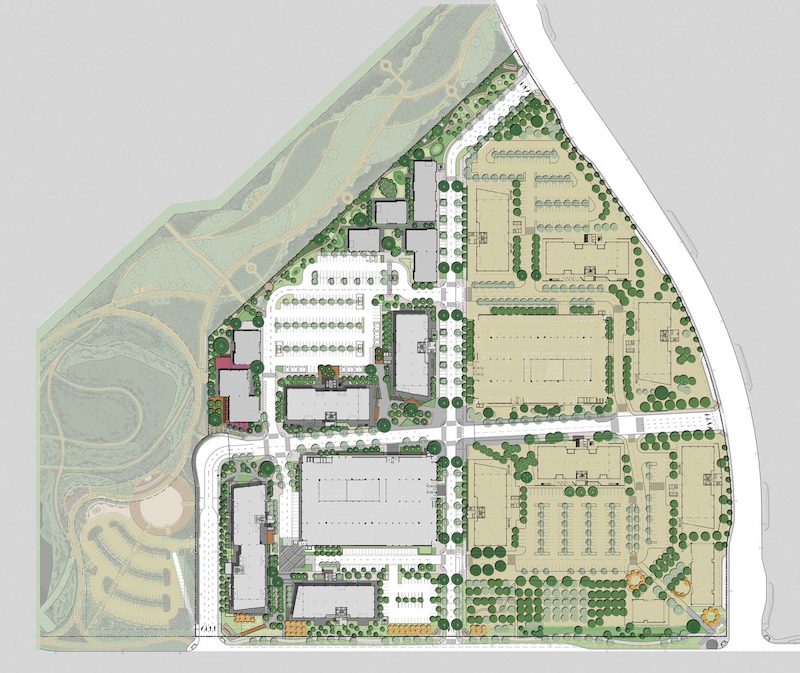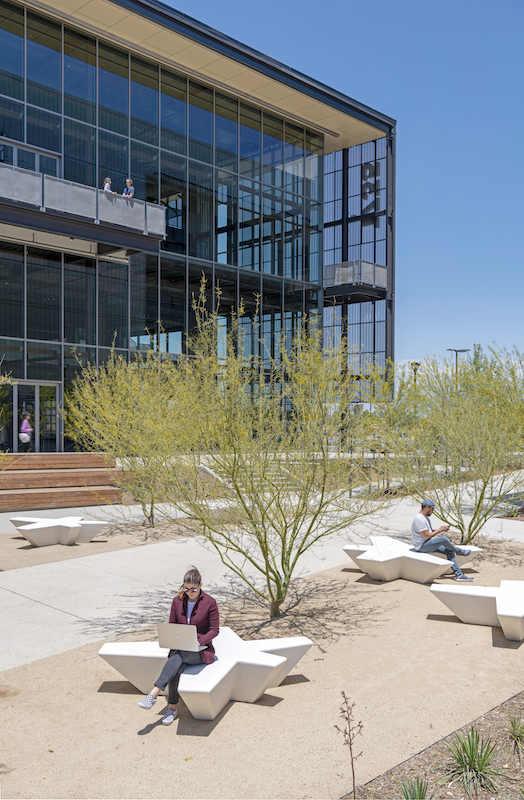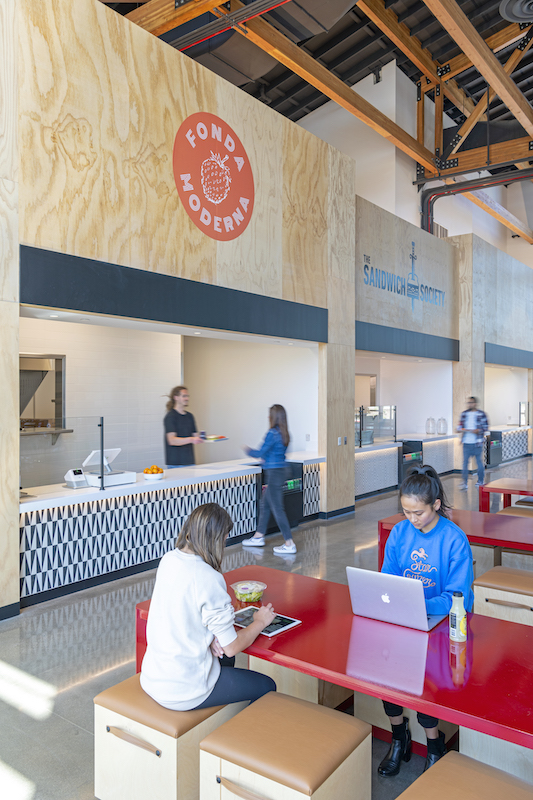FLIGHT at Tustin Legacy is a redevelopment of a former Marine Corps Air Station in Tustin, Calif., into what its developer Lincoln Property Company is promoting as the first purpose-built creative office and mixed-use campus in Orange County.
Phase 1 of this campus, whose construction was recently completed, consists of 11 buildings and 470,000 sf for offices, a food hall, and a parking garage. The site has been reimagined as a new urban neighborhood “inspired by the vernacular of aviation,” according to the project’s designer Rios Clementi Hale Studios, which collaborated with House & Robertson Architects, the EA on this project.
The campus’ 38.74-acre master plan—which will be built out in two phases—positions uninterrupted double-height buildings, which are meant to evoke airplane hangars, into grids whose pedestrian-friendly streets extend into the surrounding city, “creating a sense of openness not typically found in developments of this size.”
The campus is adjacent to the new 26-acre Tustin Legacy Park with 2.5 miles of trails, and near the Metrolink mass transit station. (An interactive map of the campus can be found here.) CBRE is this campus’ leasing agent.

The nearly 39-acre master plan includes a second phase that reportedly will include an additional 500,000 sf of office space. Image: Rios Clementi Hall Studios.
The buildings themselves push core elements such as lobbies, elevators, stairs, and services to their perimeters to increase usable interior space and catalyze user activities.
The campus includes four-story open plaza office buildings, four incubator-style office buildings, a 12,000-sf food hall and 7,000-sf conference center. About 100,000 sf of amenities—such as the food hall known as Mess Hall Market (which had a soft opening in June with 10 vendors), as well as retail shops—are scattered throughout the campus along with outdoor spaces that can accommodate private meetings and public gatherings.
“Our goal with the design at FLIGHT was to not only redefine work life and the traditional office layout, but to provide a flexible environment that can accommodate any type of tenant,” says Mark Motonaga, Creative Director at Rios Clementi Hale Studios. “In addition, we’ve introduced a collaborative environment to connect tenants with the outdoor spaces through a diversified workplace layout that encourages curiosity and creativity.”

Outdoor spaces are set up to encourage impromptu meetings and gatherings. Image: Jasper Sanidad
To complete FLIGHT on time and on budget, Suffolk, the project’s GC, implemented its “build smart” approach, which for this project meant using sophisticated virtual, design and construction (VDC) modeling tools, Lean Construction principles and a unique “plan and control” process to facilitate collaboration, increase efficiencies, minimize waste, and deliver a more predictable management process.
“FLIGHT at Tustin Legacy is a testament to our growth in this region, as well as [to] Suffolk’s ’build smart’ approach, to quickly bring this unique project to life.” says Mark Turner, Suffolk’s COO of Los Angeles.
Some of the campus’ early tenants include the retail ecommerce service provider Branded Online; the financial services company Happy Money, which took 72,000 sf on an eight-year lease; and the co-working company Work Will Win, which signed a 25,348-sf lease last April. Lincoln Property Company confirms that it is in lease negotiation with several other “high quality” tenants.
The price tag for FLIGHT at Tustin Legacy was not disclosed. However, in July 2017 Bisnow reported that HFF, working on behalf of the developer group, had arranged for $141.6 million in construction financing for Phase I.
Phase II is a 20-acre piece of land located immediately east of Phase I and is entitled for almost 500,000 sf of additional development, according to Parke Miller of Lincoln Property Company. “Given how well Phase I is leasing, we are actively site planning and drawing Phase II and talking with a handful of potential Build to Suit opportunities,” he says.

The 12,000-sf Mess Hall Market includes 10 food vendors. Image: Jasper Sanidad
Related Stories
| Oct 11, 2011
Ballard Spahr launches real estate recovery group
The new group represents an expansion of the company’s Distressed Real Estate Initiative, which was launched in 2008 to help clients throughout the country plan, adapt and prosper in a challenging economic environment.
| Oct 11, 2011
Onex completes investment in JELD-WEN
With the completion of the JELD-WEN investment, Onex Partners III is approximately 40% invested.
| Oct 7, 2011
GREENBUILD 2011: UL Environment releases industry-wide sustainability requirements for doors
ASSA ABLOY Trio-E door is the first to be certified to these sustainability requirements.
| Oct 7, 2011
GREENBUILD 2011: UL Environment clarifies emerging environmental product declaration field
White paper defines EPD, details development process, and identifies emerging trends for manufacturers, architects, designers, and buyers.
| Oct 6, 2011
GREENBUILD 2011: Growing green building market supports 661,000 green jobs in the U.S.
Green jobs are already an important part of the construction labor workforce, and signs are that they will become industry standard.
| Oct 6, 2011
GREENBUILD 2011: Kingspan Insulated Panels spotlights first-of-its-kind Environmental Product Declaration
Updates to Path to NetZero.
| Oct 5, 2011
GREENBUILD 2011: Johnson Controls announces Panoptix, a new approach to building efficiency
Panoptix combines latest technology, new business model and industry-leading expertise to make building efficiency easier and more accessible to a broader market.
| Oct 5, 2011
GREENBUILD 2011: Sustainable construction should stress durability as well as energy efficiency
There is now a call for making enhanced resilience of a building’s structure to natural and man-made disasters the first consideration of a green building.
| Oct 5, 2011
GREENBUILD 2011: Solar PV canopy system expanded for architectural market
Turnkey systems create an aesthetic architectural power plant.
| Oct 4, 2011
GREENBUILD 2011
Click here for the latest news and products from Greenbuild 2011, Oct. 4-7, in Toronto.

















